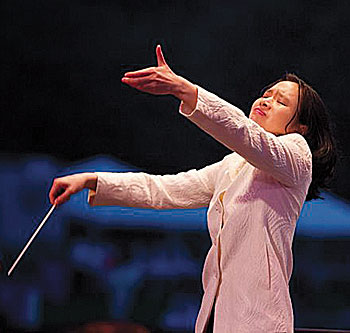
When conductor Marin Alsop sprained her wrist and withdrew from her conducting engagements this summer, the call went out to Carolyn Kuan to fill in. She was happy to step in and agreed to take on the recent works scheduled for the Cabrillo Festival of Contemporary Music, which took place without its acclaimed music director. The talented Kuan, without question a “Rising Star” who has already risen to great heights, conducted all three works on this night!
A word of professional praise is well deserved for the marvelous orchestra whose musical technical abilities under the keen ear of Carolyn Kuan are simply awesome.
Friar blended orchestral textures ranging from noises one finds common in cities like his native Los Angeles, to the tranquil canyons that can be easily accessed in the outskirts of that bizarre city environment. Friar created an interesting balance between orchestral sound and silence.
It Got Dark demonstrated Thomas Newman’s orchestral prowess, not only in the film scores for which he is known, but also in an orchestral setting as well. Newman incorporated the celebrated Kronos String Quartet (amplified) who began the work with a well-voiced chord immediately followed by a recorded voice creating a rather eerie textural effect that was supported at a low dynamic level by the entire orchestra. The soundtrack was a spoken dialogue of past, local (Los Angeles) old timers that was carefully calculated and introduced at varies times during the work. Sudden, loud bursts of orchestral sound punctuated the ghost-like texture. This was a well-written, well-performed composition.
Alternative Energy employed a wide variety of sounds to realize his work. This variety ranged from actual junkyard parts including a motor crank of days past, brake drums and related car parts used as percussion instruments. Bates himself was at the helm of his electronic panel interspersing sounds and high energy bursts of synthesized sound textures that fit the overall work quite well. Alternative Energy was Bates’ best work to date in the estimation of this writer.
•••
Dust Dances
Bremel’s Dust Dances had its roots in the Northwestern African country of Ghana, where “gyil” music is most popular. The gyil is a 14 – 18 key instrument that resembles the Western marimba. Multiple rhythms are prevalent in African music and this concept made its way into Bremel’s work. The entire orchestra realized the moments of rhythmic complexity without hesitation. Dust Dances was well received by the capacity filled Civic Auditorium.
Flute Concerto
Flute Concerto with virtuoso flautist Adam Walker received its World premiere under Kuan’s ever so precise baton. The work was co-commissioned by Bette and Joseph Hirsch to commemorate “Joe’s” 75th birthday and the couples’ 35th wedding anniversary. The work was set in three movements and Puts found space in the second movement to utilize the beautiful melody from Mozart’s Piano Concert No. 21 in C major, K. 475, which has been nicknamed the “Elvira Madigan” concerto from the Swedish film of 1967. Mozart composed this lush concerto within a four-week period and its haunting melody has survived time with glory. The third movement recapped the main theme ideas set forth in the opening movement culminating in the orchestra clapping out rhythms. The work was also well received by the audience.
Rouse’s Symphony No. 3
Of course, the anticipated high point came with Christopher Rouse’s Symphony No. 3, a most dynamic work that to a degree captured the musical soul of Sergei Prokofiev’s energetic Symphony No. 2 in D Minor, op. 40. Christopher Rouse is the current Composer in Residence of the New York philharmonic. Arguably, Rouse is a “Master Composer” and in the eyes of this writer, one of the very finest composers of our time! Prokofiev called this work his “symphony of iron and steel.” I believe highly polished titanium would be more appropriate. Program notes refer to the opening as savage and aggressive, however, missing in this statement is it is highly calculated musical composition with brilliant orchestration driven by imagination and creativity.
The second movement introduces a theme with five interesting variations. Prokofiev composed six variations. The musical ideas Rouse employed range from high orchestral tension to one that emits lush romanticism scored only for strings and two harps, beautifully performed by the spectacular Cabrillo Festival Orchestra. Under the keen ear and artistic direction of Maestra Kuan, Rouse’s Symphony No. 2 was a huge success and perhaps will be remembered as another “best work of this year’s Cabrillo Festival.”
•••
The Cabrillo Festival of Contemporary Music is America’s longest running festival dedicated to new music for orchestra. The 51st season, is scheduled to run from August 2-11, at the Santa Cruz Civic Auditorium with the season’s final August 11 performance taking place at Mission San Juan Bautista. This season features Nine composers in residence, two world premiere Festival commissions, two US premieres, two West Coast premieres and the 40th Anniversary of Kronos Quartet celebrated at this year’s Festival. Music Director and Conductor Marin Alsop. www.cabrillomusic.org/about-us/festival-orchestra.html